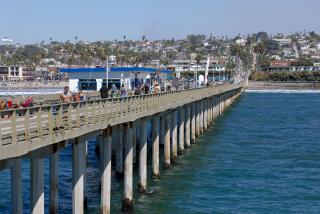Point Mugu Navy Base Gets OK to Fortify Against Natural Foe
- Share via
POINT MUGU — The Naval Air Weapons Station bristles with advanced missiles. Hawkeye E-2 planes zoom overhead. Sentries patrol the gates. The only real threat is the Pacific on the base’s western boundary.
But what a foe it is proving to be.
The eternal sloshing of tides gobbles about four feet of shoreline annually. Storms lashed the base with huge waves this past winter. And a gaping underwater canyon, spreading apart like a zipper and poised to tear into a portion of the base’s six-mile shoreline, poses a significant threat to structures and roads, officials say.
“You can protect the base from people, but you can’t protect it from Mother Nature,” said Ron Dow, head of the base environmental division.
In a bid to shore up coastal defenses, the Navy won approval Thursday from the California Coastal Commission to rebuild the base’s battered sea walls.
The commission unanimously approved the project at its regular meeting in Eureka after finding that the project would not harm shipping, the shore or the environment.
Rebuilding the sea walls will cost about $2 million, according to the Navy. Construction is scheduled to begin Oct. 1 and be completed by Feb. 15, 1999--in time to avoid breeding season for imperiled birds, including snowy plovers, least terns and light-footed clapper rails.
When functioning normally, the sea walls act as ramparts to turn back angry seas and blunt their erosive power.
But last winter’s storms tossed massive boulders aside and punched holes in the walls.
Two sea walls will be repaired and made higher, using about 25,000 tons of rock. Each sea wall spans 2,300 feet; one protects an explosives storage facility, regularly used runway and a road, according to the Coastal Commission.
The improvements should help protect the base if big storms return.
But they will not halt the spread of a bigger problem: Mugu Trench.
The underwater canyon is hundreds of feet deep and growing under natural geologic processes. The rim is now a few hundred yards offshore and swallowing the sandy bottom as it expands, and it is beginning to affect the shore at the naval base, said Mark Delaplaine, a commission staff member.
“In something less than a decade, they may have to relocate facilities and give up some areas to the ocean,” Delaplaine said. “Eventually, we’re going to have some serious problems.”
About 6,700 people are employed by the base south of Ventura. Built in 1946, it is used by the Navy to research, develop and test aircraft and missile systems.
More to Read
Sign up for Essential California
The most important California stories and recommendations in your inbox every morning.
You may occasionally receive promotional content from the Los Angeles Times.













